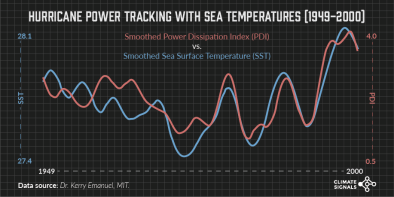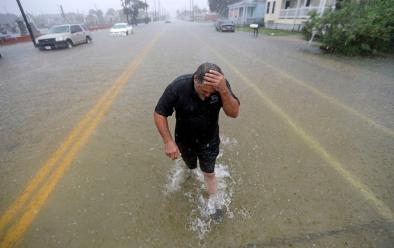Atlantic Hurricane Season 2019
The science is clear—global warming is making hurricanes worse. We’ve known for years that sea level rise sets the stage for higher damage due to storm surge. We’ve also known that warmer air holds and dumps more water when it rains.
The balance of evidence also suggests that global warming is responsible for the increase in global average intensity of the strongest tropical cyclones since the early 1980s, as well as the increase in the proportion of Category 4 and 5 storms.[1] The Fourth National Climate Assessment states, “Increases in greenhouse gases and decreases in air pollution have contributed to increases in Atlantic hurricane activity [frequency and intensity] since 1970.”[2]
Recent seasons have shown an increase in intense hurricane activity. In August and September 2019, Dorian's intensification into a Category 5 marked the fourth year in a row the Atlantic basin has had at least one hurricane reach that strength. That's the most consecutive years on record with at least one Category 5 in the Atlantic, topping a three-year stretch from 2003 to 2005.
Two years after Hurricane Harvey set a new national tropical cyclone rainfall record of 60.58 inches east of Houston, Texas, Tropical Storm Imelda has dumped up to around 40 inches of rain as of September 19.[3]







Climate science at a glance
- Global warming is fueling extreme rainfall, increasing the threat of rain and flooding driven by hurricanes.
-
Sea level rise has significantly extended the reach of hurricane-driven storm surge and coastal flooding.
-
Tropical cyclones are fueled by available heat, and warmer ocean surfaces are increasing the potential energy available to passing storms. This effectively increases the power ceiling or speed limit for hurricanes.
-
The balance of evidence suggests that global warming is responsible for the increase in global average intensity of the strongest tropical cyclones and the increase in the proportion of Category 4 and 5 storms since the early 1980s.
-
In the span of 14 months from August 2017 to October 2018, the U.S. was struck by five Category 4 or 5 cyclones.
-
Estimates of global warming's impact on rainfall rates have been calculated for at least six individual hurricanes, including Hurricanes, including Hurricanes Ivan, Katrina, Sandy, Harvey, Irma, and Maria.
-
From 2016 to 2018, rain has pushed aside storm surge as the top source of hurricane-related deaths.
- Infrastructure built to withstand the storms of the past can collapse as new extremes overwhelm and push infrastructure past design thresholds.
Background information
What factors influence hurricane development?
Hurricane development requires heat energy from the ocean surface and low wind shear. Wind shear is the term for changes in the air having to do with wind speed and/or direction with height. When wind speed and direction changes significantly with height, this creates a shearing force that tends to tear storms apart.
For example, even though the Caribbean is warm enough year-round to support hurricanes, we almost never see hurricanes in the winter or spring, because wind shear is very high these times of year due to strong upper-level subtropical jet stream winds. When low wind shear occurs in summer or fall in the Atlantic’s main development region (MDR), from the coast of Africa through the Caribbean, an active period for major hurricane activity often results.
What were recent seasons like?
In 2018, Hurricane Florence arrived during the season's peak bringing extreme precipitation and flooding to the Carolinas. Then, Hurricane Michael made landfall at the Florida Panhandle at Category 5 strength making it one of the strongest landfalling hurricanes in U.S. history.
In 2017, Hurricanes Harvey, Irma and Maria ranked among the costliest hurricanes in history and affected millions of people in Texas, Louisiana, southwest Florida, North Carolina and Puerto Rico.
Climate signal breakdown
Climate signal #1: Increased storm surge
Climate change can lead to increases in storm surge due to rising seas, increasing storm size, and increasing storm wind speeds.[1][2] Historically, storm surge has been the most important impact of tropical cyclones in coastal regions.[1] From 1963 to 2012, storm surge caused 49 percent of hurricane deaths, with rain accounting for 27 percent, according to the National Hurricane Center.[3] However, from 2016 to 2018, extreme precipitation — not storm surge — was the top source of hurricane-related deaths.[3]
Climate change has already contributed about 8 inches (0.19 meters) to global sea level rise,[4] and this has dramatically amplified the impact of cyclones by increasing baseline elevations for waves and storm surge.[4][5][6][7] A small vertical increase in sea level can translate into a very large increase in horizontal reach by storm surge depending upon local topography.
For example, an analysis by the First Street Foundation found that sea level rise was responsible for 11,000 (20 percent) of the homes impacted by Florence's storm surge.[8] During Superstorm Sandy, sea level rise extended Sandy's storm surge by 27 square miles, affecting 83,000 additional individuals living in New Jersey and New York City[5] and adding over $2 billion in storm damage.[7] Hurricane Matthew set several storm tide records during its approach to the eastern seaboard.
Observations consistent with climate signal #1
- Surge levels reached the six to seven foot range near Morgan City, Louisiana, ahead of Hurricane Barry's landfall.[9]
Climate signal #2: Extreme precipitation
One of the clearest changes in weather globally is the increasing frequency of heavy rain. As the global average temperature increases, so too does the ability of the atmosphere to hold and dump more water when it rains.[10] Atmospheric water vapor has been increasing.[11][12] And the observed increases have been studied and formally attributed to global warming.[4][13][14]
Global warming is increasing rainfall rates during tropical cyclones.[1] Over the period from 1994-2008, extreme precipitation events linked to hurricanes accounted for more than 33 percent of the observed increase in heavy events across the US.[15] The Southeast in particular saw a 40 percent increase in the amount of precipitation falling in the heaviest events, and 100 percent of this increase is linked to hurricane events.[15]
Storms reach out and gather water vapor over regions that are 10-25 times as large as the precipitation area, thus multiplying the effect of increased atmospheric moisture.[10] As water vapor condenses to form clouds and rain, the conversion releases heat that adds buoyancy to the air and further fuels the storm.[16] This increases the gathering of moisture into storm clouds and further intensifies precipitation.[10]
Scientists have found that global warming increased the rainfall rates for many individual hurricanes, including Hurricanes:

| Ivan | Katrina | Sandy | Harvey | Irma | Maria |
| [17] | [17][18] | [19] | [20][21][22][23][24] | [17] | [17] |
The increase in extreme precipitation has increased the threat of flooding, dramatically illustrated by the 1,000-year rainfall dropped by Hurricanes Matthew, Harvey, and Florence. Inland cities near large rivers in the US now experience more flooding, and this shift is consistent with climate change.
Observations consistent with climate signal #2
- Hurricane Barry’s remnants dropped 16.17 inches in Arkansas, the fifth state to post a new tropical storm or hurricane rainfall record since 2017, joining Texas, Hawaii, North Carolina and South Carolina.[25]
- During Tropical Storm Imelda, the town of Hamshire, Texas, about 10 miles southwest of Beaumont and 60 miles east of Houston, reported 25.75 inches in 12 hours and a storm total of 33.58 inches. Another report in the same general area showed an unconfirmed storm total of 40.75 inches on the morning of September 19.[34]
Climate signal #3: Intense Atlantic hurricane frequency increase
The balance of evidence suggests that global warming is responsible for the increase in global average intensity of the strongest tropical cyclones since the early 1980s, as well as the increase in the proportion of Category 4 and 5 storms.[26] The Fourth National Climate Assessment states, “Increases in greenhouse gases and decreases in air pollution have contributed to increases in Atlantic hurricane activity [frequency and intensity] since 1970.”[27] The close correlation between observed trends in recent sea surface temperatures and observed trends in the intensity of tropical cyclones reflects the link between warming ocean temperatures and stronger storms.[28][29][30]
There has been a global increase in the observed intensity of the strongest storms over recent decades.[28][31] The fingerprint of global warming in the intensity of tropical cyclones has been identified in one ocean basin: the Northwest Pacific.[32] In 2015, accumulated cyclone energy (ACE) in the western North Pacific was extreme, and human-caused climate change "largely increas[ed] the odds of the occurrence of this event."[32]
Observations consistent with climate signal #3
- Hurricane Dorian was the fifth Atlantic hurricane in four years to reach Category 5 strength and is one of the strongest hurricanes ever recorded in the Atlantic basin.[33]
Related Content












